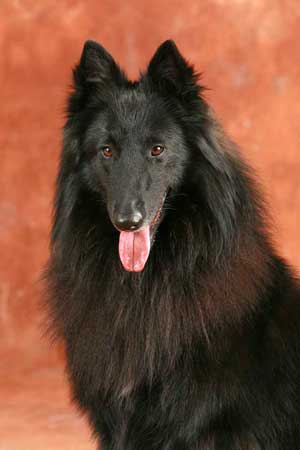|
"THE POWER OF EYES"-- February 21, 2007

Last week, I decided to pay a visit with Bing to the home of my dogwalker, Linda. Her home was a block away from where I was doing a lesson, and Bing had only been there once, when he was a few months old. The purpose of the first visit was to socialize him to cats. Bing spent his first weeks at the breeder’s with a cat, but hadn’t seen one since then. His response was mostly avoidance, but it was hard to tell because the cats more or less disappeared when he came on the scene!
The second visit was quite different. He was very excited to come into someone else’s house, that was for sure. Initially, he wouldn’t take any treats from Linda. This is a common stress response, and I wasn’t surprised. I had also brought his favorite tuggie toy, but he wasn’t initially interested in that, either. So, Linda and I sat down to observe her fish tank; Pete and I had just given her a few fish from our overcrowded tank. Bing ran around and sniffed everything for a while; found the cat food, of which he partook, checked out the cat’s climbing tree which was stuffed with Linda’s daughter’s dog toys. He was a fairly busy boy for about 10 minutes; we did a little playing with toys, he took some of the treats I brought, and then, suddenly, he became skittish.
He began to do the forward-backward motion of approach-avoidance just as we were talking about how she’d moved her furniture. The room is divided by furniture; there is a visual barrier. But that’s not what was bothering him…there was …something…over there….there…on the chair….what is that? He had found the first of three cats! I have to admit that I was surprised by his continuing fearfulness of the cat. I’m accustomed to Acacia, who does the initial approach-avoidance behavior, and then goes full-throttle into chase mode or investigative mode. Not Bing. He wanted nothing to do with CAT. He would not even look at her, much less sniff her. She just sat there quietly, curled up on the computer chair. He ran behind Linda’s chair on the other side of the room and found a nice cat cushion on which to sit, crammed tightly between the chair and the wall.
By this time, Bing had decided to take some of my treats from Linda, so she lured him out from behind the chair. He then offered his typical routine show of sit, down, relax, shout, paw, knee, spin, twist, shout, and jump up on the person and accost her for treats (see the previous blog by Sue Sanders, who taught him this lovely behavior!). He finally seemed to be relaxing when he noticed something…there…above him….what IS that? Oh no! Another CAT!!! This one was up on a shelf, crouching but relaxed, watching Bing with great amusement. Her eyes were humongous and beautiful. And then it dawned on me…he’s afraid of cats because they STARE!!!
If there’s one thing I spend lots of time teaching about, it’s canine body language. Staring is NOT a very nice canine behavior. To a dog, a stare is an invitation to a confrontation. And Bing wanted none of it. He returned to his hiding place, but spent more time looking up than anywhere else. The third cat made a brief appearance from atop another shelf, and gave a quiet, long look at Bing, but by then he’d had enough. He started poking me with his nose in that sweet “time to go now, Lady” tone…so we made our thanks you’s and exited.
I’m not sure why I felt like I had really learned something that evening, but I did. If I had spent any time thinking about it, I would have realized that Bing is fearful of cats because they stare. But I had never really had reason to spend time thinking about it. Shortly after my first visit to Linda’s, I took Bing to a pet food store, and in it was a kitten in a cage. Despite its young age, it displayed all the appropriate defensive postures, including a giant stare. Bing was terrified and pulled me toward the door. There was no convincing him to go anywhere near that cage. Acacia, on the other hand, would stop at nothing to torment the creature, and would need to be removed from the store due to her loud and excited barking. Montana would have gone right up to the cage and stared, without moving an inch, at the kitten. So perhaps I’m just not accustomed to this fearful behavior toward cats.
One last association I made to this behavior refers to a rally trial we attended in November, 2006. The trial was held in a horse arena, and one of the rings was situated at the end of the arena, near some plywood doors. In those doors was a hole; perhaps it was a knot in the wood, but it had become hollowed out. There seemed to be another mark that could have also been a hole; it was difficult to tell from the distance I was standing. While Acacia and I were trialing, she stopped dead in her tracks and stared straight ahead. It took me a few second to realize she was staring at this configuration in the wood. I revived her attention and we continued our course. Then it was Bing’s turn…he did precisely the same thing! I have no idea if other dogs did this, as I wasn’t really paying attention to other dogs (Bing is a full time job at a trial!) but afterward, I realized that they both perceived these markings as eyes!
HA!
See? You learn something new every day!
Post Script:
After writing this blog, it occurred to me that the very sensitivity to cats’ eyes might be the same reason Bing is such a great player with other dogs. It is a well-known fact that dogs display calming signals and that they use body language extensively. Perhaps there are some wonderful subtleties to Bing’s body language, and sensitivity of other dogs’ body language which allows him to gauge their reaction and, hence, the interaction. Bing has been known to get dogs to play whose owners say that dog hasn’t played in years. When this happens once in a while, you just figure it’s chemistry. When it happens on a regular basis, it’s magic!
Comment to the Webmaster about this story. Your comments may be posted.
Comment to Ali in private.
Return to the Main Blog Page.
|
|

